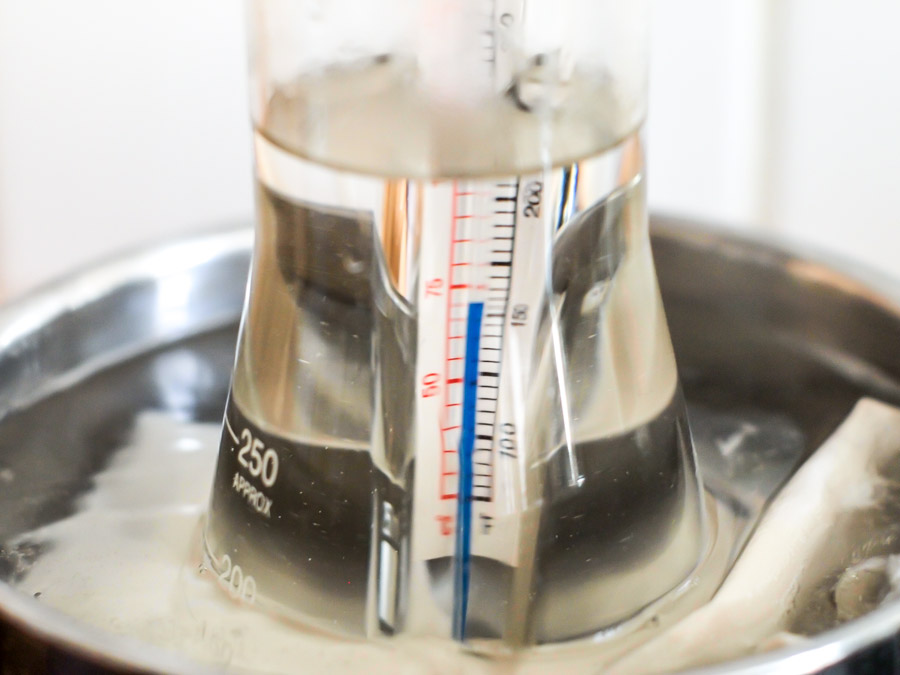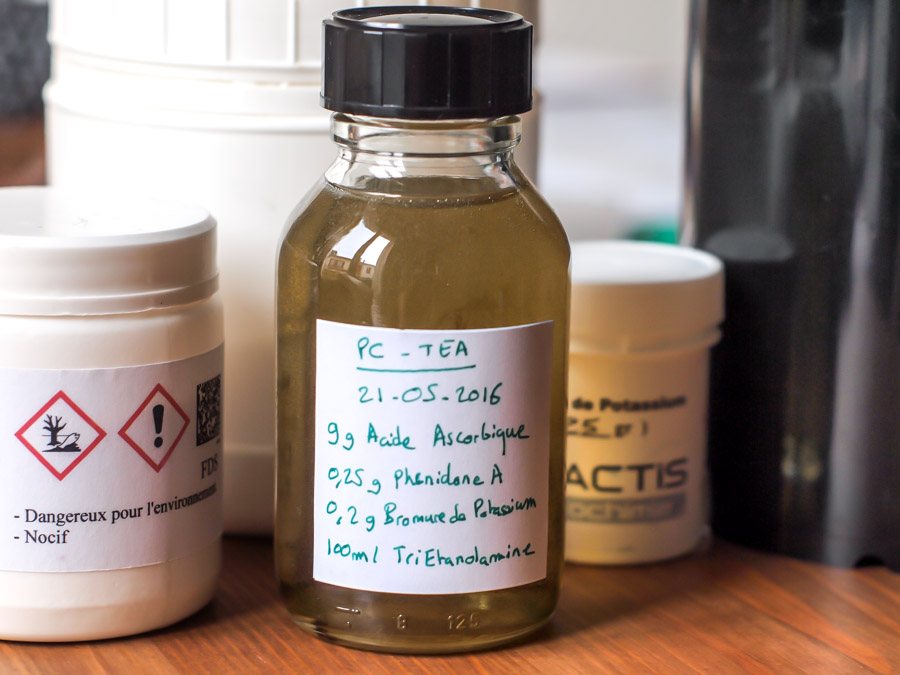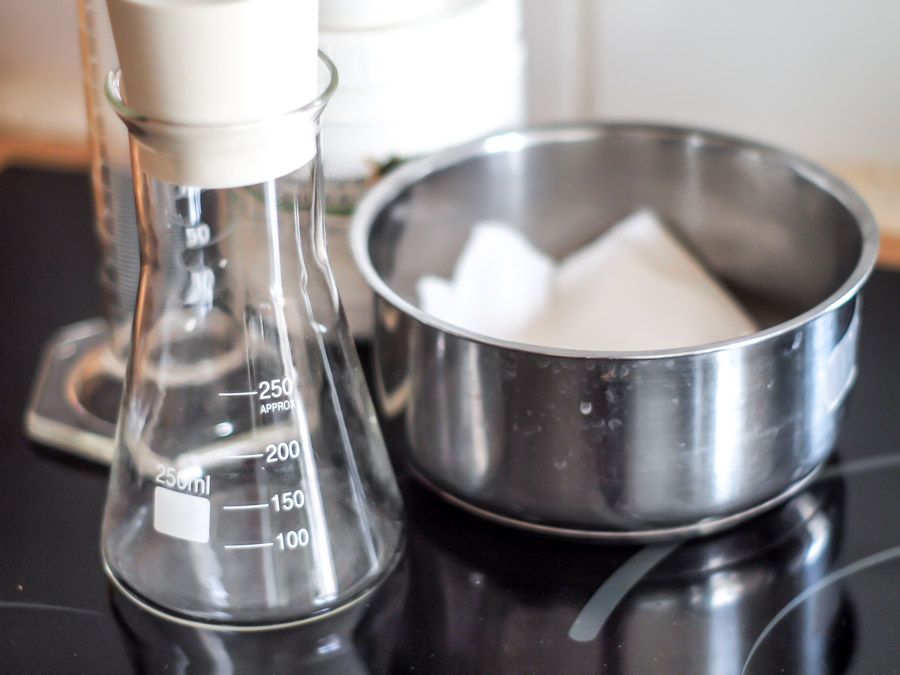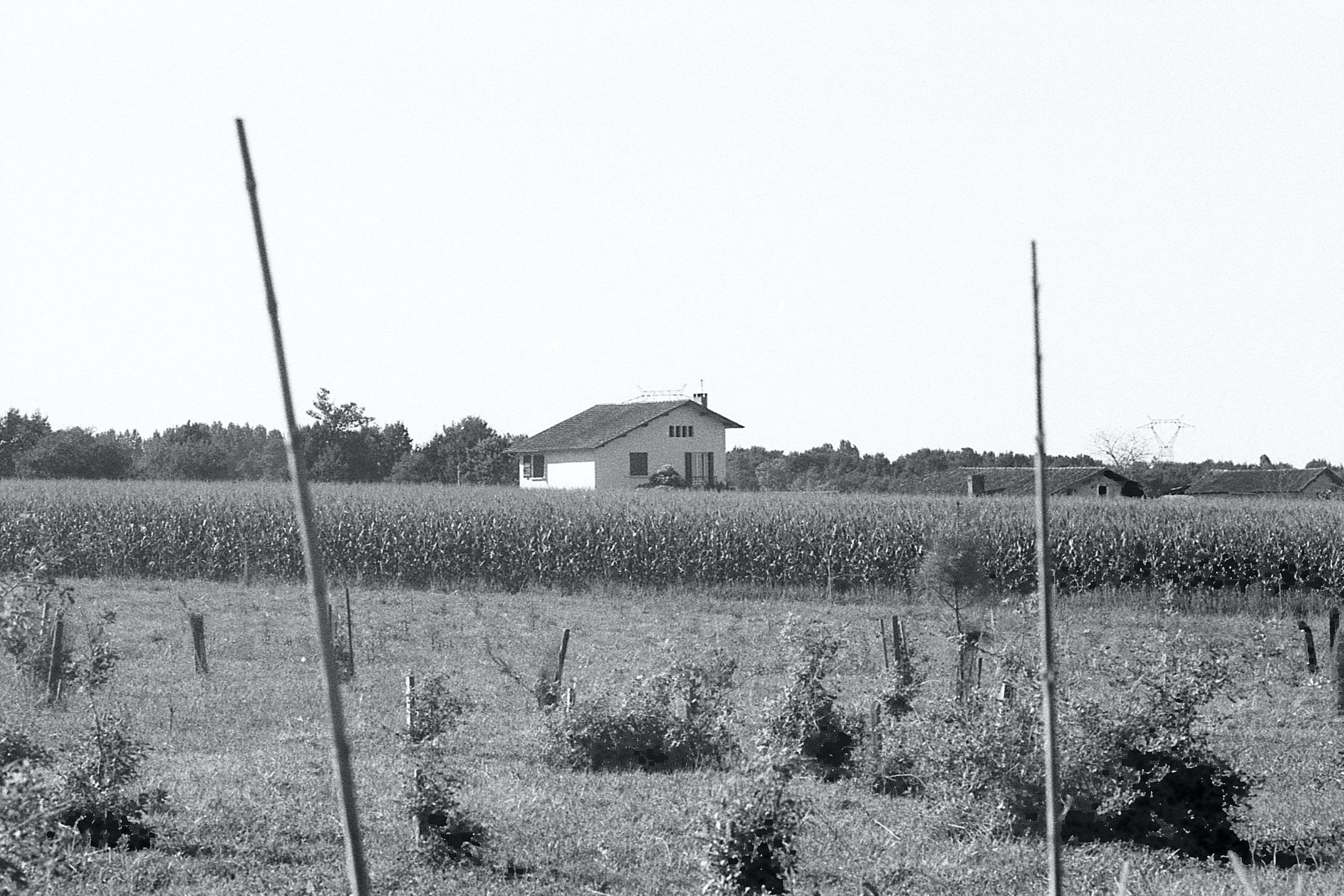Four years ago, I drafted a post about PC-TEA, a pretty confidential developer created by Pat Gainier that I tried to reproduce from his website. Since then, I used it several times, mainly for contact sheets, and forgot about it. Lately, I have been once again researching a cheap, reliable, and more eco-friendly developer than the Pyrocat HD that I use on a regular basis.
In my lab gear, I dug up a little glass bottle I made in 2016, nearly full. I decided to test my luck and give it a try on an entire roll of film.
How does it work?
OK. Before going any further, you do need to know how a developer works. I do not want to go too deep into the details but it still might be painful for those of you who do not care about chemistry that much — you can skip this part —.
For the rest, get into your lab coats and hold on to your butts, we are going for it.
The photographic developers acts in a reduction–oxidation reaction (redox).
Every developer on the market contains at least three active parts (and an optional extra one):
- A developing agent, usually a phenol: The developing agent is what will actually paint your photo, by transforming the latent image into metallic silver. In most developers, the developing/reducing agent is from the hydroquinone family (like in ID-11) or metol.
- An activator: by reacting, the reaction changes the developer pH. If that pH is too low (too acidic), the developing agent gets oxidised and the reaction slowly stops. The developing agent needs a basic solution in order the reaction to be completed. That is why a developer always has a basic compound in the mix. It usually is sodium carbonate, or sodium hydroxide.
- A anti-oxidation agent, which will prevent the aerial oxidation, especially from the storage duration.
- An anti-fog agent: Optional. It allows the developer not to contaminate empty areas during long development times. It usually is Potassium bromide.
OK you can relax, that is all you need to know about developers! If you want to see a fun experiment, you can check out my Caffenol article, about making a developer out of washing soda, coffee and vitamin C!
So why make a new developer?
The all-star developing agent is Hydroquinone. It gives great results. The problem is that Hydroquinone it is a mutagen and may even cause cancer. Most phenols are dangerous anyway. The developing agent in my to-go developer is Pyrocatechol, which is highly volatile and even classified as a poison.
The developing agent in PC-TEA is much nicer: It is based on phenidone and ascorbic acid (vitamin C). Phenidone has a low toxicity and does not cause skin irritation (only toxic if ingested). And vitamin C, well, you know already (oranges, peppers, broccoli, all the good stuff). The only issue with these two compounds is that they oxidize REALLY fast and are therefore pretty sensitive to oxygen (and that is why you should drink your orange juice FAST before it all disappears — this post is not affiliated with Minute Maid—).
The other great aspect of PC-TEA is, as its name might state, it uses TEA. TEA is not the nice Darjeeling you are thinking about, but another name for triethanolamine, which is a harmless chemical used in A LOT of beauty and medical products. It emulsifies creams and shampoos and adjusts and buffers the pH. This is exactly where it gets interesting. Unlike water, TEA by itself is a basic solution that keeps the phenidone and the vitamin C from oxidizing. It basically plays both roles of the activator and the saving agent.

TEA therefore allows to have a virtually infinite shelf life, and this article proves it. Four years after making the solution, it still works perfectly!
The recipe for a perfect cup of PC-TEA
Get into the kitchen, it is time to cook!
Here is the Recipe for a perfect cup of PC-TEA
| Ingredient | Role | Quantity |
|---|---|---|
| TEA | Activator, protects against aerial oxidation | 100 ml |
| Ascorbic Acid | Developing agent | 9 g |
| Phenidone A | Developing agent | 0.25 g |
| Potassium Bromide | Anti-fog | 0.2 g |
The goal is to heat the TEA at about 250°F (120°C), adding the ascorbic acid and bromide and stir until it is completely dissolved, which, believe me, can take quite a long time.
By the time the ascorbic acid has dissolved, the temperature of the solution should have dropped to below 150°F (65°C). It is then time to add the phenidone and stir again until dissolved.

The key of the recipe is constant stirring. It is exhausting. It feels like the powders never properly dissolve. When done, the color can be yellow to light brown. This is due to the high temperatures and does not affect the recipe. After a few years, the solution gets darker and darker (like a nice tea, get it?), due to the slow oxidation that the TEA cannot contain. So far, I did not see time adjustments and continue to use it as new.

The usual development times are around 10 minutes.
For use, dilute it either 1:50 or 1:100 with water.
Yes, you read correctly. 1:100. That soup sure is cheap!
In a word, you have a relatively low toxicity developer, that keeps forever and does not cost anything per roll of film. What else could you possibly want?
STILL NOT CONVINCED?
Here are some pictures taken in 2018, and processed in PC-TEA. I will post more as soon as I get back to my lab.
Shot on Nikon FE in August 2018, on Ilford HP5+ and processed in PC-TEA













Very cool! I like mixing my own developers, stops, ect, because a bag of mixed powder tends to go bad before I use it up and also because I’ve always been in to chemistry thanks to a high school chemistry teacher in 1978.
I’ve also gotten hooked on The Dark Room Cookbook. This is a nice addition to my arsenal.
Thanks for sharing! Very detailed and friendly guide.
I had many rolls devloped by PC-TEA with very impressive result! I used it for one-shot instead of more costy xtol. It seems no difference I could tell.
It’s good to know that PC-TEA lasts over 4 years, which I didn’t try yet. That’s also a good reason to use it over xtol.
Thank you for your feedback!
Yes, PC-TEA is nearly eternal, and it used it even more after I wrote that post.
I find it slightly superior to XTOL in definition.
Do you now use XTOL or did you switch to PC-TEA ?
I’ve just used some PC-TEA that I mixed up over 10 years ago. It’s very, very dark, but still just as active as the day it was mixed.
Hello,
How do you heat the solution to 250 degrees F, when boiling point is 212? I would seem that you require a pressure cooker?
Hello, and thanks for stopping by.
It seems I made a mistake back when I wrote this post (2016). It is possible to reach slightly over 212°F with the TEA properties under heat, but indeed never 250°F. It also turns out it is not necessary.
Most recipes ask for 250°F, that you can reach with a glass dish in an oven, and that was the original recipe. However, Pat Gainer, the inventor, used later recipes with only heating to 160°F, and it also worked perfectly. The warmer solution gets the easier it is to mix in the other Ingredients. But if it doesn’t reach 250 degrees, it will still work, it will just require more time (solution is darker when warmed, but it does not affect the properties).
In the end it’s up to you : oven or boiling water!
@ Harold Klee: Boiling point for TEA is appr. 335*C (635*F), so reaching 250*F is not a problem (unless, of course in a waterbath…).
However, it is desirable to keep the temperature to a minimum needed to dissolve phenidone and asc.acid. Higher than nescessary temp is likely to affect the ‘longevity’ of the mix….
If heating in a waterbath: TEA (as well as glycol) is somewhat hygrosopic (absorbs water from the air). Keep the bottle closed, and dry it off before opening! Any water into the mix, and the keeping properties definitely will go down.
@ Pierre Killmayer: Thank you for a very nice article!
Hello Pierre,
a very interesting article – beautiful pictures, too! The production process looks easy enough, with a boiling water bath of 212°F / 100°C: I’m planning to use a magnetic stirring and heating plate that will – hopefully – be able to stir the TEA… otherwise, muscle power is the solution. Regarding the developing times, Massive Dev Chart gives only little data for PC-TEA, especially not on push development. Can you make some data available, from your own experience or from a third source?
Regards
Denis
Hello Denis, Thank you very much!
I am confident you will not have any trouble with a stirring plate.
As for developing times, it has been a while since I switched to other formulas, and I do not remember. I will look in my notebooks and come back to you as soon as I can. I think I will update the articles with my experience feedback.
Pierre
I’ve gotten some informaton about PC-TEA developing times from a lab in China (where I live). At 1:25 dilution, use the same times as D-76 stock. At 1:50, use the same times as D-76 1+1. At 1:100, use the same times as Rodinal 1:100 or just general (semi) stand development.
Thanks for the article, some good information. I’m just about to embark on the journey of homebrew developers, and a PC-TEA with KBr is what I’m drawn to. Interested to know if you have further experiences with it, maybe Dimezone S over phenidone, but also qualities over different films. Also, you have moved on to a different or improved developer?
Col
Where obtain Phenidone in Canada?
Thanks!
casey